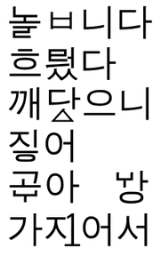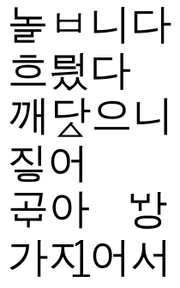
New Orthography for the Korean Language
Encyclopedia

Spelling reform
Many languages have undergone spelling reform, where a deliberate, often officially sanctioned or mandated, change to spelling takes place. Proposals for such reform are also common....
used in North Korea
North Korea
The Democratic People’s Republic of Korea , , is a country in East Asia, occupying the northern half of the Korean Peninsula. Its capital and largest city is Pyongyang. The Korean Demilitarized Zone serves as the buffer zone between North Korea and South Korea...
from 1948–1954. It added five consonants and one vowel letter to the hangul
Hangul
Hangul,Pronounced or ; Korean: 한글 Hangeul/Han'gŭl or 조선글 Chosŏn'gŭl/Joseongeul the Korean alphabet, is the native alphabet of the Korean language. It is a separate script from Hanja, the logographic Chinese characters which are also sometimes used to write Korean...
alphabet, making it what is believed to be a more morphophonologically
Morphophonology
Morphophonology is a branch of linguistics which studies, in general, the interaction between morphological and phonetic processes. When a morpheme is attached to a word, it can alter the phonetic environments of other morphemes in that word. Morphophonemics attempts to describe this process...
"clear" approach to the Korean language
Korean language
Korean is the official language of the country Korea, in both South and North. It is also one of the two official languages in the Yanbian Korean Autonomous Prefecture in People's Republic of China. There are about 78 million Korean speakers worldwide. In the 15th century, a national writing...
.
The reason for the reform is that some Korean roots change form and therefore cannot be written with a consistent spelling using standard hangul. The additional letters introduced in the New Orthography do not represent new sounds, but these situations where a sound changes, say from a /p/ to a /w/. Three were created de novo by modifying existing letters, two (ㅿ and ㆆ) were obsolete letters, and one (1) is a numeral.
For example, the root of the verb "to walk" has the form 걷 kŏt- before a consonant, as in the inflection 걷다 kŏtta, but the form 걸 kŏl- before a vowel, as in 걸어 kŏrŏ and 걸으니 kŏrŭni. In New Orthography, the root is an invariable
 , spelled with the new letter ㅿ in place of both the ㄷ in 걷 and the ㄹ in 걸:
, spelled with the new letter ㅿ in place of both the ㄷ in 걷 and the ㄹ in 걸:  다 kŏtta,
다 kŏtta,  어 kŏrŏ.
어 kŏrŏ.Another example is the root of the verb "to heal", which has the form 낫 nas- before a consonant, as in 낫다 natta, but the form 나 before a vowel, as in 나아 naa. In some cases, there is an epenthetic ŭ vowel before a consonant suffix, as in 나을 naŭl. In New Orthography, this variable root is written as an invariable
 , and the epenthetic vowel is not written:
, and the epenthetic vowel is not written:  다 NA’.DA for 낫다 natta,
다 NA’.DA for 낫다 natta,  ᄅ NA’.L for 나을 naŭl,
ᄅ NA’.L for 나을 naŭl,  아 NA’.A for 나아 naa.
아 NA’.A for 나아 naa.| Letter | | Pronunciation | |
|---|---|---|
| before a vowel | before a consonant |
|
 |
/l/ | —1 |
 |
/nn/ | /l/ |
| ㅿ | /l/ | /t/ |
| ㆆ | —1 | / ͈/2 |
 |
/w/3 | /p/ |
 |
/j/4 | /i/ |
- Silence.
- Makes the following consonant tense, as a final ㅅ does
- In standard orthography, combines with a following vowel as ㅘ, ㅙ, ㅚ, ㅝ, ㅞ, ㅟ
- In standard orthography, combines with a following vowel as ㅑ, ㅒ, ㅕ, ㅖ, ㅛ, ㅠ
As with all letters in North Korea, the names follow the formula CiŭC. For convenience they are also called 여린리을, 된리을, 반시읏, 여린히읗, 위읍, and 여린이.
The New Orthography also added two new digraphs
Digraph (orthography)
A digraph or digram is a pair of characters used to write one phoneme or a sequence of phonemes that does not correspond to the normal values of the two characters combined...
to the lexicon, ㅭ lʔ and ᇬ ŋk.
There were other changes that made the orthography more morphemic, without requiring the addition of new letters. For example, in the word normally spelled 놉니다 (top example in image at right), the politeness morpheme ㅂ is separated out in its own block. Such spellings can be found in medieval documents, but weren't normally seen in the 20th century.
The attributive ㄴ n morpheme at the ends of adjectives is also placed in a separate block, and the occasional epenthetic ŭ that appears before it is not written, unlike standard 은 ŭn. A morphemic h is retained before this ending: 하얗다 HA.YAH.DA hayata "is white", 하얗ㄴ HA.YAH.N hayan "white" (standard 하얀 HA.YAN). 좋다 CHOH.DA jota "is good", 좋ㄴ CHOH.N chohŭn "good" (standard 좋은 CHOH.ŬN).

